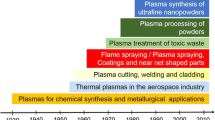Abstract
Modeling of a counterflow plasma reactor is presented, using liquid injection for the synthesis of fine particles. An experimental reactor has been developed in this laboratory, and feasibility has been demonstrated for synthesizing advanced ceramic powders. The flow field calculations show two major recirculating regions which are of importance for increasing the particles' residence time inside of the reactor. In addition, the temperature within these recirculation zones remains relatively uniform. For simulation, water droplet trajectories have been calculated for droplets produced by an injection probe. It is shown that the droplets in a size range below 50 μm in diameter will follow the streamlines and evaporate completely within a short traveling distance. This finding suggests that this reactor configuration provides a favorable environment for the synthesis of fine particles using liquid precursors.
Similar content being viewed by others
References
T. Or, Z. Lu, L. Stachowicz, P. Kong, and E. Pfender, “Counterflow Liquid Injection,” Plasma Synthesis of Spinel Powders, MRS Spring Meeting, April 17–19, 1990.
B. Waldie,Trans. Inst. Client. Eng. 49, 114 (1971).
K. Hardtl,Chem. Ing. Tech. 39, 1253 (1967).
K. C. Hsu, “A self-consistent model for the high-intensity free-burning argon arc,” Ph.D. thesis, Dept. of Mech. Eng., Univ. of Minnesota (1982).
D. L. Evans and R. S. Tankin,Phys. Fluids 10, 1137 (1967).
Y. C. Lee and E. Pfender,Plasma Chem. Plasma Process. 7, 1 (1987).
W. Chen, private communication (1989).
J. P. Van Doormaal and G. D. Raithby,Numer. Heat Transfer 7, 147 (1984).
Xi Chen and E. Pfender,Plasma Chem. Plasma Process. 2, 293 (1982).
E. Bourdin, P. Fauchais, and M. Boulos,Int. J. Heat Mass Transfer 26, 567 (1983).
M. C. Yuen and L. W. Chen,Combust. Sci. Technol. 14, 147 (1976).
Y. C. Lee, Y. P. Chyou, and E. Pfender,Plasma Chem. Plasma Process. 5, 391 (1985).
E. Pfender,Plasma Client Plasma Process. 9, 167S (1989).
Xi Chen,Pure Appl. Chem. 60, 651 (1988).
Xi Chen and E. Pfender,Plasma Chem. Plasma Process. 3, 97 (1983).
Xi Chen and P. He,Plasma Chem. Plasma Process. 6, 313 (1986).
Xi Chen and E. Pfender,Plasma Chem. Plasma Process. 2, 185 (1982).
Y. P. Chyou, “Modeling of thermal plasma systems,” Ph.D. thesis, Dept. of Mech. Eng., Univ. of Minnesota ( 1987).
J. A. Lewis and W. H. Gauvin,AIChE J. 19, 982 (1973).
Xi Chen, J. Qiu, and J. Yang,Plasma Client. Plasma Process. 11, 151 (1991).
M. Vardelle, A. Vardelle, P. Fauchais, and M. I. Boulos,AIChE J. 29, 236 (1983).
Author information
Authors and Affiliations
Rights and permissions
About this article
Cite this article
Paik, S., Chen, X., Kong, P. et al. Modeling of a counterflow plasma reactor. Plasma Chem Plasma Process 11, 229–249 (1991). https://doi.org/10.1007/BF01447244
Received:
Revised:
Issue Date:
DOI: https://doi.org/10.1007/BF01447244




